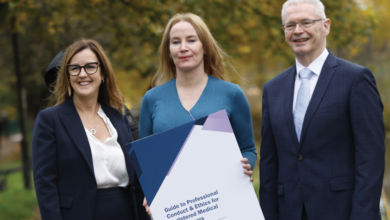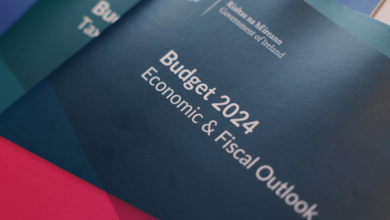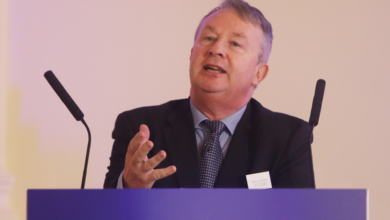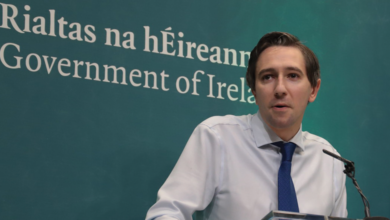Analysing Ireland’s public health expenditure

Two 2020 reports by the Economic and Social Research Institute (ESRI) give us an insight into how Irish healthcare expenditure is allocated and how this compares with the country’s European counterparts.
The first of these reports, published in May, entitled An analysis of trends in Irish public healthcare expenditure and staffing, analyses trends in healthcare expenditure and staffing in Ireland between the years 2004 and 2017. One of the key findings of the report is that “although there was a large increase in nominal public current healthcare expenditure during this period, the rate of increase is reduced when adjustments are made for increases in price, population growth and, in particular, population ageing”.
For instance, the nominal increase in health expenditure between 2004 and 2017 is a significant 74.2 per cent. However, once this figure is adjusted for price and population ageing, it becomes a much smaller 2.1 per cent. The average annual increase in expenditure during that period falls from a nominal 4.4 per cent rise to a real rise of 0.2 per cent when adjusted. Further, the report states that the “share of public healthcare expenditure, which was accounted for by capital expenditure, shrank from 5.1 per cent in 2004 to 3.2 per cent in 2017”, which suggests that “increases in public current healthcare were partially funded through reductions in public capital healthcare expenditure”.
In line with overall expenditure figures showing significant dips in the 2008-2013 period, the report shows that while HSE pay expenditure and staffing increased by 4.4 per cent from 2007 to 2017, these figures decreased by 1.6 per cent from 2007 to 2010 and by 5.6 per cent from 2010 to 2013. As the report points out: “The employment control framework, characterised by incentivised early retirement, voluntary redundancy and a moratorium on recruitment, was applied across these two time periods due to the financial crisis.”
The report also stresses that the “discussion of healthcare expenditure would benefit by placing trends into the context of changing prices and demographics” and that examining the expenditure in per capita terms is also essential due to population growth and the projected continuation of such growth. Related to both the employment control framework and Ireland’s growing and ageing population is the amount of early retirement plans the HSE now has in its expenditure. These packages were agreed with the aim of short-term cost-saving at a time of severe austerity, but the report warns that they “may, in fact, lead to increased expenditure over time”.

Real total public health expenditure per capita increased by 46.5 per cent between 2004 and 2017, with an annual average increase of 3 per cent. Real public expenditure per capita increased by 23.3 per cent in the same period, an average annual increase of 1.6 per cent. Real public expenditure per capita over 65 increased by just 0.1 per cent over the period, an annual average increase of just 0.007 per cent, which “suggests that public healthcare expenditure kept pace with the increases in price and in the size of the population aged 65 and over in Ireland between 2004 and 2017”.
These increases were, however, “front loaded”, with over 65 per capita real spending increasing by 26.1 per cent from 2004 to 2008 but decreasing by 20.2 per cent from 2008 to 2013 and again by 0.6 per cent from 2013 to 2017.
How Ireland compares with Europe
Based on the 2017 data, the ESRI has subsequently released a new report, ‘How does Irish healthcare expenditure compare internationally?’, published in October, in order to contextualise Irish healthcare spending within the OECD and the EU15.
The study found that Ireland ranks differently depending on the other measures of healthcare expenditure required. Ireland’s total healthcare expenditure as share of national income ranks first in the EU15, while total healthcare expenditure per capita with adjustment for relative pricing places Ireland ninth. This category can be further broken down into public and private; Ireland ranks ninth in public health expenditure per capita and second in private health expenditure per capita.
“Discussion of healthcare expenditure would benefit by placing trends into the context of changing prices and demographics.”
Another of the major takeaways was the inconsistency of countries in their classification of social care expenditure. 10 of the EU15 allocated some social care expenditure to healthcare-related expenditure, which is not counted in healthcare expenditure, but Ireland allocated €4.6 billion to social care within its healthcare expenditure and none under healthcare-related expenditure. Included in this figure is €900 million paid to family carers, a figure that the Netherland does not account for in its health spending. Ireland includes all home care, group homes and day services in its expenditure, figures that the UK largely excludes.
With health and social care expenditure combined, Irish public health spending per capita with adjustment for relative prices ranks 10th in the EU15. Maev-Ann Wren, ESRI Senior Research Officer and the lead author of the report, said: “Understanding Ireland’s apparently relatively high healthcare expenditure needs to be informed by an understanding that Ireland’s relatively high prices and wages have obscured the continuing relatively low volume of Irish healthcare services delivered.”





